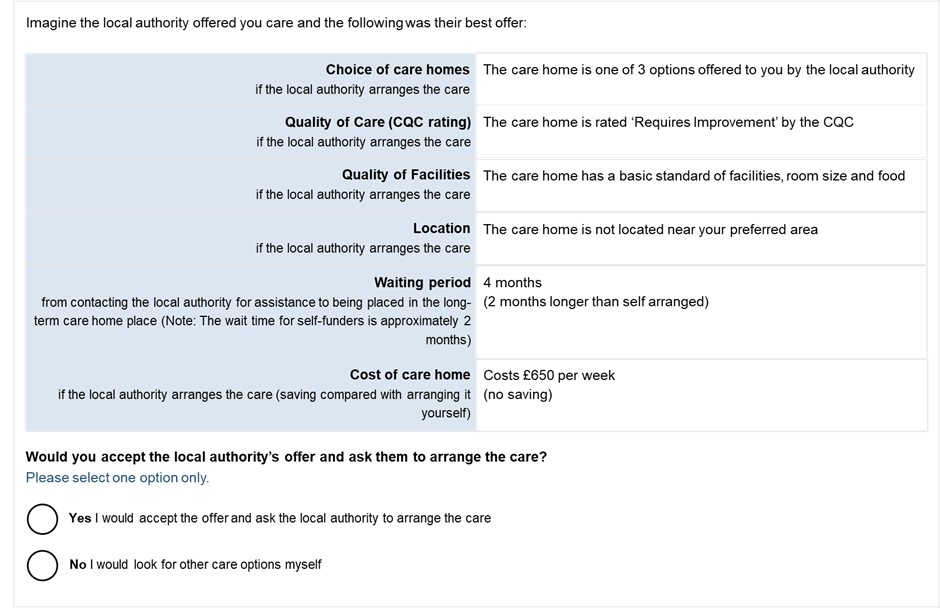Using a Discrete Choice Experiment to understand the public’s decision-making around arranging and paying for residential care
In 2023, Ipsos conducted research on behalf of the Department of Health and Social Care (DHSC) to explore how likely those expected to self-fund any necessary future residential care would be to involve their local authority in arranging the care and the factors influencing their decisions.
Introduction
In 2023, Ipsos conducted research on behalf of the Department of Health and Social Care (DHSC) to explore how likely those expected to self-fund any necessary future residential care would be to involve their local authority in arranging the care and the factors influencing their decisions.
A planned policy, referred to as Section 18(3) of the Care Act 2014, would give self-funders the right to request that their Local Authority arranges their residential care placement on their behalf. The local authority would handle the placement arrangements but the self-funder would remain responsible for paying the full cost of the care. Currently self-funders are likely to pay higher rates for a care home place. The planned policy would have allowed self-funders to access the same rates as state-funded care users.
The research was designed to help DHSC understand how to plan and support the social care sector for these changes and estimate the likely proportion of self-funders who would choose to take up Section 18(3) when the policy was implemented. Although the introduction of Section 18(3) is not being taken forward at the time of writing, insights gained about how people plan to arrange and pay for residential care for themselves or a loved one are still relevant.
The research also has wider applications as it shows how a discrete choice experiment could be used to explore decision making on a complex social policy issue with the general public. In this blog we describe the methodology and what we learned from it.
The full report and findings have been published by Ipsos.
Methodological approach
The research had three key aims:
- to estimate the likely uptake of the policy (among self-funders in England who would be entering residential care for the first time).
- to determine the proportion who would be very unlikely to want the local authority involved in arranging their care, irrespective of the particular offer of care.
- to understand how circumstances and the characteristics of the care home place offered influence choices and behaviour.
To generate the evidence required to meet these objectives, Ipsos designed a sophisticated, mixed-methods research approach. First we conducted some qualitative research with stakeholders and the general public to inform scope out the topic, understand decision making around care and help shape materials and questions for the next stage. Following a survey, qualitative interviews explored the findings which emerged in more detail.
We conducted a large-scale online survey with the general public (aged 30 and over who would potentially be a self-funder, or support a self-funder) using Ipsos KnowledgePanel. The survey contained an advanced choice-base experiment, known as a Discrete Choice Experiment (DCE). A DCE is a quantitative research technique, typically used in market research, to quantify people's preferences and priorities when making complex decisions between different products or product characteristics. It is especially useful for understanding choices in fields like healthcare, where decisions often involve weighing up multiple factors simultaneously.
For this research, the DCE was used to understand which care home characteristics would have the greatest influence on self-funders' likelihood of choosing a placement arranged by their local authority compared to arranging one privately. In a DCE, the item being chosen between (in this case a care home placement arranged by the local authority) is broken down into its key characteristics or 'attributes'. For a care home, relevant attributes could include the quality of care, facilities, location, and the cost difference from arranging the care oneself. Each attribute is then further specified in terms of a limited number of possible variations or 'levels'. The key attributes and levels tested in the DCE were:
- Number of care homes offered by the LA to choose from (Levels: 2, 3 or 4 homes)
- Care home's CQC quality rating (Levels: Outstanding/Good/Requires Improvement)
- Standard of facilities, rooms and food (Levels: Basic/Good/Premium)
- Location of the care home (Levels: Within/Near/Not near preferred area)
- Waiting time for a place (Levels: 2/4/6 months)
- Weekly fee rate and potential savings compared to self-funding (Levels: combinations of £650-£850/weekly cost and £0-£340/weekly savings)
Based on these attributes and levels, the DCE generated different hypothetical local authority placement offers which combined different levels of each attribute. Participants were shown 12 of these offers in turn and asked whether or not they would take up the offer from the local authority or arrange the care themselves.
DCE exercise example

By modelling participants' choices across all 12 offers, covering different attribute level combinations, sophisticated statistical models were used to estimate the relative value participants place on each attribute and the impact each one has on the likelihood of choosing for the local authority to arrange their care.
The results showed that the care home's CQC rating and the potential weekly fee savings compared to self-arranging care were the two most influential attributes. An 'Outstanding' CQC rating increased uptake likelihood while a 'requires Improvement' rating decreased it substantially. Higher weekly fees decreased likelihood of an offer being accepted while greater savings compared to self-funding increased likelihood. The results also showed that negative attributes had a bigger impact on uptake of an offer of care from the local authority than positive ones. For example, compared to a ‘middle’ offer based on the middle level of each attribute, a ‘requires improvement’ rating decreased the preference share by -40% while an outstanding rating increased the preference share by 11%.
The variation in intended uptake of local authority care arrangements according to the characteristics of the offer provides quantitative evidence on the uncertainty surrounding uptake of the new policy. This improves understanding of the type of information required at different stages to enable people to make informed choices. General information about the policy would be important in raising awareness and enabling people to explore it, but until provided with specific information about how it would work in their particular case, people are unlikely to be able to decide whether they would take up the option of the local authority arranging residential care. The follow up qualitative interviews, provided further insight into their decision making and the importance of specific information and exploring all options in making decisions.
Female, arranging care for someone else, uncertain about whether would take up offer:
Yes, I would take on board local authority suggestions and I would very much be open to seeing what is on the table. I would equally want to do my own research. I would equally want to go out and see what I can source to make sure all avenues are looked at.
This uncertainty and need for specific information might apply to many other policies, where detailed research on decision making processes would provide more nuanced insights than general questions to the public about likely uptake of a policy or decision making with limited information.
The design of the DCE also allowed us to see how decision making varied according to whether the hypothetical move to the care home was taking place via hospital discharge or from a community setting and whether people were considering care for themselves or someone else. This increased the sophistication of the understanding from the research, and enabled consideration of how common variations in how care is arranged in practice can affect decision making. This offers insights into how information about care is communicated and to whom and how this may affect engagement with policies.
The DCE thereby provided an understanding of which characteristics of a care home self-funders and their loved ones are likely to prioritise when making their decisions about arranging care. This information can help local authorities, care providers and policymakers assess the likely impact of policy changes relating to arranging and funding care and put appropriate plans in place to prepare for implementation. The research also shows how similar choice based research approaches could be applied to provide a deeper understanding of other complex policy challenges and decisions in adult social care and beyond.
More insights about Public Sector


